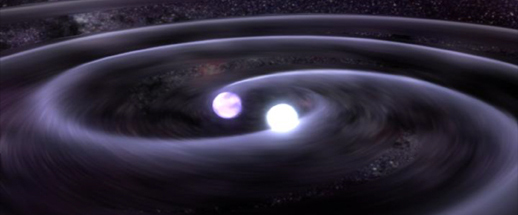
An artist's impression of two merging white dwarf stars. (Illustration: GSFC/D. Berry)
|
Binary WDs: Doppler Beaming and Gravitational Waves
There is rarely a month that goes by without a popular science article screaming in a headline about "Einstein proved right" or "was Einstein right?" This is due to the fact that Einstein's ideas still have the staying power to captivate modern audiences. The extreme environments of white dwarf stars offer two tangible ways in which humans can directly observe both special and general relativity.
Special relativity introduced the concept that an observer's frame of reference compared to a source must be considered; it decoupled the notion that time and space were the same for all observers, and gave us situations where time and space can dilate or contract depending on an observer's motion relative to a source.
Doppler beaming is an excellent and specific example of special relativity in action; it is a measurable effect for many compact binaries composed of at least one low-mass white dwarf. Doppler beaming essentially derives its amplitude from a Lorentz transformation of the opening angle of radiation from an object, which causes an increase in observed flux from a rapidly moving source toward our line of sight.
Imagine an object that is radiating away energy equally in all directions. If we fully account for special relativity in our treatment of the angle of how such light is emitted from a source, we find that the angle of the emission depends slightly on the velocity of the source. If the motion is fast enough in the direction of an observer, the radiation can be "beamed" toward that observer. Mathematically, if the source is at rest, the angle of emission is simply cos(α') = cos(α). However, if the source is in motion then
where V=v/c is the dimensionless radial velocity of the source (its motion toward or away from an observer). There is a similar dependence on the frequency of the emitted radiation with the source velocity, but the dominant factor contributing to Doppler beaming of a ~10,000 K white dwarf comes from the beaming of the opening angle of the radiation.
This Doppler beaming introduces a detectable modulation in the flux of a source that is approaching or receding, and is an exciting confirmation of special relativity we can see in the white dwarf stars. Up until the start of this decade, Doppler beaming had never been observed from the ground; it's now something we do routinely with low-mass white dwarfs and subdwarf stars.
Additionally, low-mass white dwarfs can say something profound about the general theory of relativity. In so many words, Einstein's general relativity holds that gravity is a manifestation of the consequence that mass bends space. A popular visualization involves imagining a heavy object like a bowling ball resting atop a sheet of spandex, stretching the surface of the spandex into a ball-shaped indention. The amount of stretching an object imparts on space is directly proportional to that object's mass.
This warping of space can have interesting consequences. In the case that two objects are in close orbit around each other, they often perturb each other just via gravity; they are forced to bob up and down in the wake of each other's mass-bent space. This bobbing accelerates each object, which in turn causes the emission of gravitational waves, subtle ripples in the fabric of space-time.
These ripples carry energy and angular momentum; subtle as they are, they can carry away enough energy to cause the orbits of two stars to decay quite rapidly, especially if those stars are close together. Gravitational waves cause such a minute effect on space-time that humans have never directly detected them, despite hundreds of millions of dollars spent over decades trying. Humanity's first confirmation of these subtle waves came in the mid-1970s when radio astronomers measured the orbital decay of a merging binary system containing a pulsar, a rapidly spinning neutron star that keeps exceptionally precise time due to its millisecond spin period. It turns out that low-mass white dwarfs can also contain accurate clocks, and we have used the eclipses from an exceptional 12.75-min WD+WD binary to detect and measure the orbital decay of this system, due mostly to gravitational radiation (Hermes et al. 2012). This is the first time that gravitation waves have been indirectly detected using visible light.
|